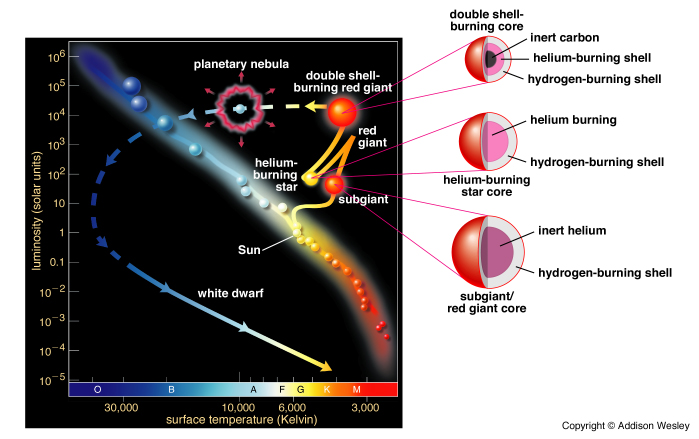
T






The Death of a Massive Star:
Stars up to approximately 8
times
the mass of the sun follow a
life
track similar to that of the
Sun. Larger stars, however, are
vastly different. We can follow a 12 solar mass star as an example.
Starting
off blue
white it expands, cools and
starts to turn yellow. For
a while it becomes unstable
pulsing in and out for about a month. As it
shrinks and expands
in
turn its brightness changes in a regular way. It has become a
Cepheid
variable star.

Eventually
the massive stars becomes a Red
SUPERGIANT
one thousand times larger
than
the Sun, shedding some of its material along the way. In the
star's
core
a
series of different nuclear process keep it shinning. Low-mass stars,
such
as the Sun, can burn hydrogen and sometimes helium, but the temperature
in the core is too low to support nuclear reactions involving nuclei
with
larger charges. Massive stars, on the other hand, can attain
temperatures
so high that not only helium but even heavier elements such as carbon
can
fuse. Eventually,
Iron (Fe)
is
produced in the core and an iron core thousand kilometers across is
formed.
Iron is the most stable of nuclei so heavier elements can be produced
in
stars but now at an expense in energy.

At that critical moment, the
core
collapses
rapidly (under a tenth of a second) until it is
less than a kilometer
across
and some of the highest densities ever observed in the Universe are
produced.
Part of the imploding material produces a shock wave which blows the
star
apart and produces one of the most cataclysmic events in the universe:
A
Supernova
explosion.

Just
a few years ago (1987) astronomers and high-energy physicists observed
a Type
II Supernova
in the Large
Magellanic
Cloud; a small companion galaxy about 160,000 light years from
us.

The supernova, the explosion of a 15 solar mass blue supergiant star, was named SN1987A.Never before in the history of humanity had such an event been studied and recorded so precisely. About 20 hours before the supernova was detected with optical telescopes, the Earth was bathed in a 13-second burst of neutrinos from the exploding star. These neutrinos were recorded by underground experiments in Japan and the United States. This was the first time in human history that mankind recorded neutrinos from a dying star. In reality, of course, the star exploded about 160,000 years ago. Since then, the neutrino pulse has been expanding into space like a huge inflating bubble. The Earth passed through the bubble in 1987, at an epoch in our history in which we were technologically able to witness and record the event. If the bubble had passed us just a decade earlier, the whole event would have gone unnoticed - as the means to record the event were not yet in place.

Before and AftER: The brightest
star in the left picture is the first supernova to be visible to the
unaided
eye for almost 400 years. It occured in a region rich in young, blue
stars
and it was one of these which destroyed itself. When this picture was
taken,
about 2 weeks after the supernova was discovered, at the end of
February,
1987, the expanding shell of material had already changed from blue to
orange-red as it cooled. The location of the supernova in the Large
Magellanic
Cloud (LMC) means that it can only be seen from the southern
hemisphere.
This was very convenient in the early stages of the development
of
the supernova, since the LMC is always above the horizon of the AAT.
Type I Supernovae:

Also caused by the collapse of a star but in this case the star is a white dwarf (typically 0.6 solar masses). The mass of the white dwarf, however, may increase if it has a companion star. If the amount of hydrogen accreted onto a white dwarf causes the star's mass to exceed 1.4 solar masses then the white dwarf will collapse and eventually explode as a Type I supernova, leaving no remnant behind.
Type II Supernovae:
As we will see in the next
chapter,
leave behind as a remnant a Neutron
Star
or a Black Hole.
In 1928, while
on
his way to England from India, a graduate
student by the name of Chandrasekhar calculated that a star heavier than about 1.4 solar
masses cannot
remain
stable; it will collapse. If the star's mass is less than 1.4
solar
masses, however, it can remain as a stable white dwarf. The 1.4 solar
mass
limit is known as the Chandrasekhar
Limit.
Nova Star:
We know that binary-star systems
are very common. So it is possible to have a white dwarf star paired
with
a companion star. Hydrogen from the companion star can be deposited
onto
the white dwarf. This is called accretion. The accreted hydrogen forms
an accretion disk in orbit about the white dwarf. As the hydrogen
swirls
down onto the white dwarf it heats up eventually reaching a temperature
above 10
million degrees K- a temperature hot enough for hydrogen to fuse into
helium. This triggers an explosion called a nova; a Nova
is
a thermonuclear explosion on the surface of a white dwarf. Yet, this
explosion
at the surface, hardly disturbs the white dwarf and its companion star.
Thus, sometimes this process can repeat itself. In this case the binary
is called a recurrent nova.

The European Space Agency's ESA
Faint Object Camera utilizing the corrective optics provided by NASA's
COSTAR (Corrective Optics Space Telescope Axial Replacement), has given
astronomers their best look yet at a rapidly ballooning bubble of gas
blasted
off a star. The shell surrounds Nova Cygni 1992. Nova Cygni is 10,430
light
years away and is located in the summer constellation Cygnus the Swan.
Nova Cygni erupted on February 19, 1992. A nova is a thermonuclear
explosion
that occurs on the surface of a white dwarf star in a double star
system.